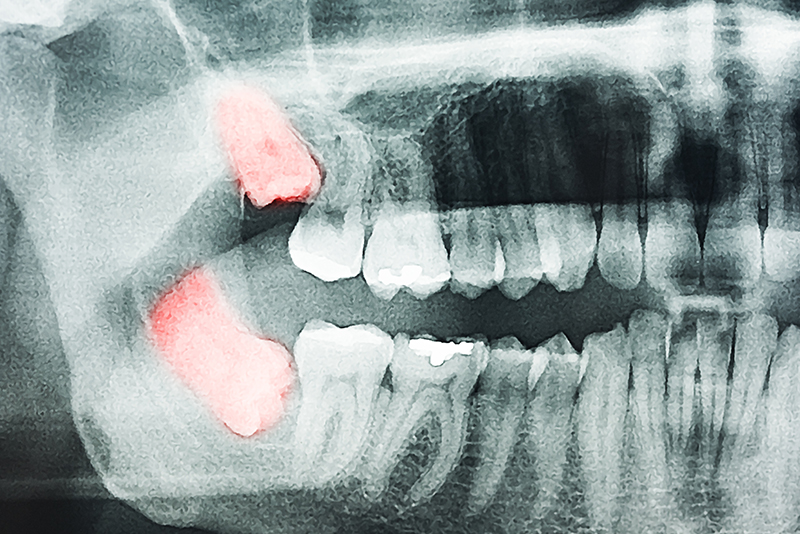
Wisdom Teeth
In modern humans, wisdom teeth have little purpose. In fact, in many people, they can become impacted and do more harm than good. Therefore, patients will often choose to have their wisdom teeth extracted as a preventive measure to guard against negative oral health outcomes.
For many patients, wisdom tooth extraction is their first encounter with oral surgery, so it can be helpful to know what to expect from the treatment planning process and from the procedure itself.
If your wisdom teeth have not yet erupted and you’d like to explore the benefits of having impacted wisdom teeth extracted, call Mid Cities OMS to schedule an evaluation.
Value Of Preventive Wisdom Tooth Extraction
The third molars, otherwise known as the wisdom teeth because they tend to erupt in the late teens or the “age of wisdom,” are quite large. In our ancient ancestors, they served important functions in processing a rough diet and replacing teeth that were lost to injuries, damage or oral diseases.
However, as humans have evolved, our jaws have gotten smaller. As a result, many of us no longer have enough room in the smile for the wisdom teeth to erupt correctly, causing them to become impacted.
Impacted wisdom teeth can become problematic in multiple ways, including:
• Increasing the risk of infection or abscesses
• Developing cysts or tumors
• Causing discomfort as they continue to attempt to erupt
• Damaging surrounding teeth or pushing them out of the proper position
To avoid these outcomes, many patients will opt for wisdom tooth extraction. Whenever possible, patients should pursue extraction no later than age 25. In older patients, the process to remove the teeth is more complex and there is an extended timeline for healing.
What To Expect From Wisdom Tooth Extraction
The wisdom tooth extraction process begins with an evaluation at our office. This allows Dr. King to gather all of the information needed to plan for the procedure.
Mid Cities OMS uses advanced imaging tools to plan for wisdom tooth extraction with the most predictable results possible. Cone Beam Computed Tomography (CBCT) produces three-dimensional images that provide a more realistic representation of the surgical field, improving the predictability of the procedure.
At this consultation, you will also have a chance to discuss your sedation options with Dr. King. Many patients choose IV sedation for maximum convenience and comfort.
If you select IV sedation, you must have a responsible adult escort you home from the appointment, as you will not yet be able to drive safely when you leave our office. You also will need to fast for a period of time before your extraction, as directed by Dr. King.

Taking Care Of Yourself After Wisdom Tooth Extraction

Wisdom tooth extraction is an outpatient surgical procedure that is completed in just a couple of hours. Before you go home, our staff will give you written instructions for post-operative care to reduce your risk of complications, such as infections or dry sockets.
It’s essential to follow these instructions closely and monitor for unusual symptoms for the best possible post-operative outcomes and an uneventful healing period.
Additionally, we’ll give you a list of symptoms that are cause for concern and warrant a follow-up call to our office. These symptoms may include:
• Persistent or severe bleeding
• Persistent or severe pain
• Noticeable signs of infection (such as pus)
• Visible dry sockets
Common Questions about Wisdom Teeth
How long does it take to recover from wisdom teeth extraction?
The length of the recovery period following wisdom tooth extraction depends on various factors, including the patient’s age, overall health, and compliance with post-operative instructions. In the best-case scenario, patients should only need to take a few days off of work or school until the initial healing period is complete. Dr. King will also ask you to avoid more vigorous activity and certain foods for a week or longer.
How long does it take for the hole to close after a wisdom tooth extraction?
It can vary from patient to patient, but on average, the soft tissue at the extraction site will start to feel normal again in around three weeks. It takes six weeks or more for the bone and gum tissue to heal completely, however.
How long does it take for local anesthesia to wear off after wisdom teeth removal?
The local anesthetic will start to wear off after about 2-4 hours. Follow Dr. King’s directions for pain management if you start to experience any discomfort after the local anesthetic’s effects are reversed.
What does a dry socket look and feel like?
A dry socket may appear noticeably dry to an observer, and the protective blood clot will be absent. You will likely be able to see the whitish bone underneath the empty socket. Pain associated with a dry socket will persist beyond the first few days after the extraction and it will be more severe, sometimes radiating throughout the entire side of the face. Keep in mind that you can reduce your risk of dry sockets by following Dr. King’s post-operative instructions and avoiding activities that could dislodge the blood clot, such as using drinking straws or chewing food in the area of the extraction site.
Is it normal to have pain while swallowing after wisdom teeth removal?
Patients are likely to notice some discomfort in the hours immediately following wisdom tooth extraction after the anesthetic has worn off. However, this symptom should resolve within 48 hours or so. If the pain is severe or if it lasts for a few days or more, contact our office for further direction.
